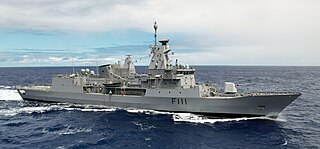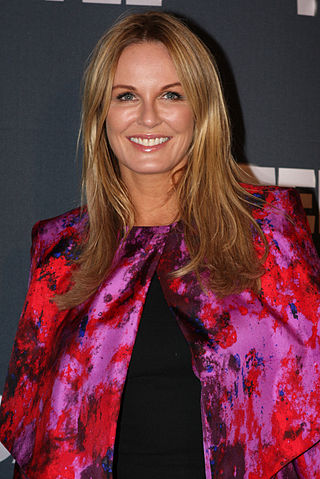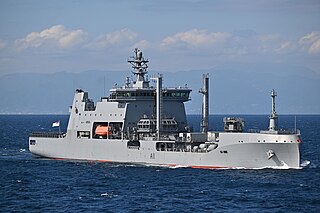Related Research Articles
The New Zealand Defence Force is the three-branched military of New Zealand. The NZDF is responsible for the protection of the national security of New Zealand and her realm, promoting its interests, safeguarding peace and security, as well as supporting peacekeeping and humanitarian missions. It consists of three services: the Royal New Zealand Navy (RNZN), the New Zealand Army and the Royal New Zealand Air Force (RNZAF), as well as 'tri-service' components. As of June 2023, the NZDF has a strength of 14,996 employees, consisting of 8,669 regular force personnel, 3,260 reserve force personnel and 3,067 civilian members. It is supported by the New Zealand Ministry of Defence (MOD) and is commanded by the Chief of Defence Force (CDF).

HMNZS Achilles was a Leander-class light cruiser, the second of five in the class. She served in the Royal New Zealand Navy in the Second World War. She was launched in 1931 for the Royal Navy, loaned to New Zealand in 1936 and transferred to the new Royal New Zealand Navy in 1941. She became famous for her part in the Battle of the River Plate, alongside HMS Ajax and HMS Exeter and notable for being the first Royal Navy cruiser to have fire control radar, with the installation of the New Zealand-made SS1 fire-control radar in June 1940.

HMAS Echuca (J252/M252), named for the town of Echuca, Victoria, was one of 60 Bathurst-class corvettes constructed during World War II, and one of 36 initially manned and commissioned by the Royal Australian Navy (RAN).

The Royal New Zealand Navy is the maritime arm of the New Zealand Defence Force. The fleet currently consists of nine ships. The Navy had its origins in the Naval Defence Act 1913, and the subsequent acquisition of the cruiser HMS Philomel, which by 1921 had been moored in Auckland as a training ship. A slow buildup occurred during the interwar period, and then in December 1939 HMS Achilles fought alongside two other Royal Navy cruisers at the Battle of the River Plate against the German ship, Graf Spee.

HMAS Stawell (J348/M348) was a Bathurst-class corvette named for the town of Stawell, Victoria. Sixty Bathurst-class corvettes were constructed during World War II, and Stawell was one of 36 initially manned and commissioned solely by the Royal Australian Navy (RAN).

HMNZS Te Kaha (F77) is one of ten Anzac-class frigates, and one of two serving in the Royal New Zealand Navy (RNZN). The name Te Kaha is Māori, meaning 'fighting prowess' or 'strength'.

HMNZS Te Mana (F111) is one of ten Anzac-class frigates and one of two serving in the Royal New Zealand Navy (RNZN). The name Te Mana is Māori, approximately translating as 'status' or 'authority'. The ship was laid down under the joint Anzac project by Tenix Defence at Williamstown, Victoria in 1996, launched in 1997, and commissioned into the RNZN in 1999.

HMNZS Canterbury is a multi-role vessel (MRV) of the Royal New Zealand Navy. She was commissioned in June 2007, and is the second ship of the Royal New Zealand Navy to carry the name. She is also New Zealand's first purpose-built strategic sealift ship.

HMNZS Wellington (P55) is a Protector-class offshore patrol vessel in the Royal New Zealand Navy.
The British Commonwealth Far East Strategic Reserve was a joint military force of the British, Australian, and New Zealand armed forces. Created in the 1950s and based in Malaya, the FESR was conceived as a forward defence point for Australia and New Zealand, while protecting Commonwealth interests in the Southeast Asian region from both internal and external communist threats. The FESR was made up of an infantry brigade and an aircraft carrier group, supported by squadrons of aircraft.

HMNZS Waikato (F55) was a Leander Batch 2TA frigate of the Royal New Zealand Navy (RNZN). She was one of two Leanders built for the RNZN, the other being the Batch 3 HMNZS Canterbury. These two New Zealand ships relieved British ships of the Armilla patrol during the Falklands conflict, freeing British ships for deployment.
HMNZS Tui, formerly USNS Charles H. Davis (T-AGOR-5), was one of nine Conrad class oceanographic ships built for the United States Navy (USN), that later saw service in the Royal New Zealand Navy (RNZN). Serving with the USN from 1963 to 1970, these ships were designed to perform acoustic experiments on sound transmission underwater, and for gravity, magnetism and deep-ocean floor studies.

HMNZS Otago (P148) is a Protector-class offshore patrol vessel in service with the Royal New Zealand Navy. The development of the OPV design based on an Irish Naval Service OPV class was very contentious, with the RNZN arguing for the need for a limited combat suite for effective training and patrol work with a 57 mm–76 mm light frigate gun and associated fire control, radar and electronic warfare systems at least compatible with current 2nd light RN OPVs. The government and Cabinet preference was to use the space and extra finance available to incorporate ice strengthening and provision of extra coastal patrol vessels. The RNZN view was that adding ice strengthening was unnecessary for Southern Ocean patrols, distinct from operations in the Ross Sea, and the extra weight and complexity would stress and shorten the life of the hulls from 25 to 15 years. She was launched in 2006 but suffered from problems during construction and was not commissioned until 2010, two years later than planned. Soon after commissioning Otago encountered problems with both her engines which delayed her arrival at her home port of Port Chalmers. She has served on several lengthy patrols of the Antarctic, though she lacks the capability to operate in heavier levels of ice-coverage which has led to the cancellation of at least one planned operation.

HMNZS Rotoiti (F625) was a Loch-class frigate of the Royal New Zealand Navy (RNZN), which had formerly served in the British Royal Navy as HMS Loch Katrine at the end of World War II.

HMNZS Endeavour (A11) was a fleet oiler for the Royal New Zealand Navy. She was named after James Cook's Bark Endeavour and the third ship in the RNZN to carry that name, though if continuity with the Royal Navy ships of the name HMS Endeavour is considered, she is the twelfth. The previous two ships of the RNZN were Antarctic research support vessels. Endeavour was built in South Korea to a commercial design and commissioned on 8 April 1988, and decommissioned on 15 December 2017.

HMNZS Canterbury (F421) was one of two broad beam Leander-class frigates operated by the Royal New Zealand Navy (RNZN) from 1971 to 2005. She was built in Scotland and launched in 1970. Commissioned in 1971, Canterbury saw operational service in much of Australasia and other regions like the Persian Gulf. She undertook operations such as supporting UN sanctions against Iraq and peace-keeping in East Timor. With her sister ship HMNZS Waikato she relieved the Royal Navy frigate HMS Amazon in the Indian Ocean during the Falklands War. Early in HMNZS Canterbury's career, in 1973, she relieved the frigate HMNZS Otago, as part of a unique, Anzac, naval operation or exercise at Moruroa during anti-nuclear protests, supported by a large RAN tanker, providing fuel and a large platform for Australian media. This was due to F 421 being a more modern RNZN frigate, with then current Rn surveillance radar and ESM and a more effectively insulated frigate from nuclear fallout, with the Improved Broad Beam Leander steam plant, for example, being remote controlled and capable of unmanned operation and therefore the ship provided a more effective sealed citadel for operations in areas of nuclear explosions.

The New Zealand Division of the Royal Navy also known as the New Zealand Station was formed in 1921 and remained in existence until 1941. It was the precursor to the Royal New Zealand Navy. Originally, the Royal Navy was solely responsible for the naval security of New Zealand. The passing of the Naval Defence Act 1913 created the New Zealand Naval Forces as a separate division within the Royal Navy.

Charlotte Dawson was a New Zealand–Australian television personality. She was known in New Zealand for her roles as host of Getaway, and in Australia as a host on The Contender Australia and as a judge on Australia's Next Top Model. In 2014, her death by suicide attracted Australasian-wide news coverage.

The New Zealand Special Service Medal (NZSSM) was established by royal warrant by Elizabeth II, Queen of New Zealand on 23 July 2002. The medal serves to recognize military service that would not otherwise be recognized by a Campaign medal.

HMNZS Aotearoa, formerly the Maritime Sustainment Capability project, is an auxiliary ship of the Royal New Zealand Navy. Builder Hyundai Heavy Industries delivered the ship to the Navy in June 2020, and she was commissioned into service on 29 July 2020. Full operational capability was expected to be achieved in 2021. The vessel will serve as a replenishment oiler, and has replaced HMNZS Endeavour, the Navy’s last fleet oiler, which was decommissioned in December 2017.
References
- 1 2 3 Casinader, Jehan (1 November 2006). "An Asian affair". Unlimited Magazine. Archived from the original on 21 October 2008. Retrieved 12 September 2008.
- 1 2 Scherer, Karyn (1 October 2007). "A chance to see history in the making". New Zealand Herald. Retrieved 12 September 2008.
- ↑ "New Zealand Special Service Medal (Asian tsunami)". New Zealand Defence Force. Archived from the original on 15 October 2008. Retrieved 12 September 2008.
- 1 2 3 "Charlotte Glennie, China Correspondent". Australia Network. Retrieved 12 September 2008.
- ↑ "Charlotte Glennie". Metro. December 2006. Retrieved 12 September 2008.[ permanent dead link ]
- ↑ "Women2Watch". Diocesan School for Girls. Archived from the original on 14 October 2008. Retrieved 18 September 2008.
- 1 2 "Insight - Prime time" (PDF). Auckland University of Technology. Archived from the original (PDF) on 19 July 2011. Retrieved 12 September 2008.
- ↑ Devereux, Monique (22 August 2001). "Unlucky break for TV reporter". New Zealand Herald. Retrieved 12 September 2008.
- ↑ Zander, Bianca (22 January 2005). "Upfront: Charlotte Glennie". The Listener. Retrieved 12 September 2008.
- ↑ "New Zealand Navy pays first visit to Vladivostok, Russia". Vladivostok Novosti. 14 June 2005. Archived from the original on 21 May 2008. Retrieved 13 May 2008.
- ↑ "Navy Today - Sea Passage to Russia" (PDF). Royal New Zealand Navy. August 2005. Archived from the original (PDF) on 21 May 2010. Retrieved 12 September 2008.
- ↑ "Secretive Nation". TVNZ. 24 October 2005. Retrieved 12 September 2008.
- ↑ "(Video) One News Asia correspondent Charlotte Glennie after Nguyen Tuong Van's execution". TVNZ. 2 December 2005. Archived from the original on 19 May 2011. Retrieved 12 September 2008.
- ↑ Drinnan, John (10 August 2007). "Kirk on the (press) bench". New Zealand Herald. Retrieved 12 September 2008.
- ↑ "ABC Correspondent Charlotte Glennie updates the China quake situation". Australian Broadcasting Corporation. 13 May 2008. Retrieved 12 September 2008.
- ↑ "China opens aperture for foreign media to top athletes". Xinhua News Agency. 10 November 2007. Archived from the original on 16 June 2008. Retrieved 12 September 2008.
- ↑ "ABC crew assulted[sic] by Chinese official". Australian Broadcasting Corporation. 20 March 2008. Archived from the original on 8 November 2012. Retrieved 12 September 2008.